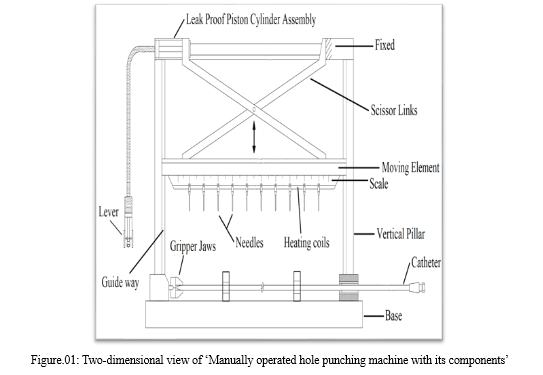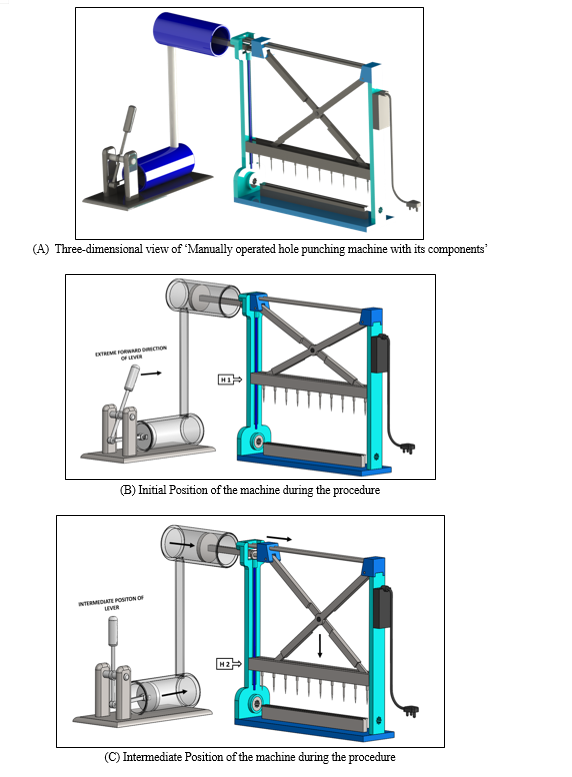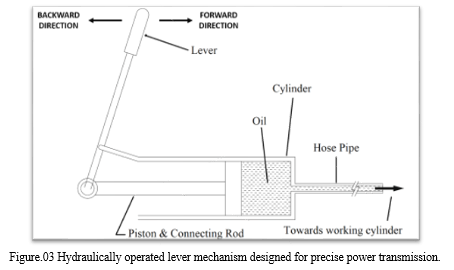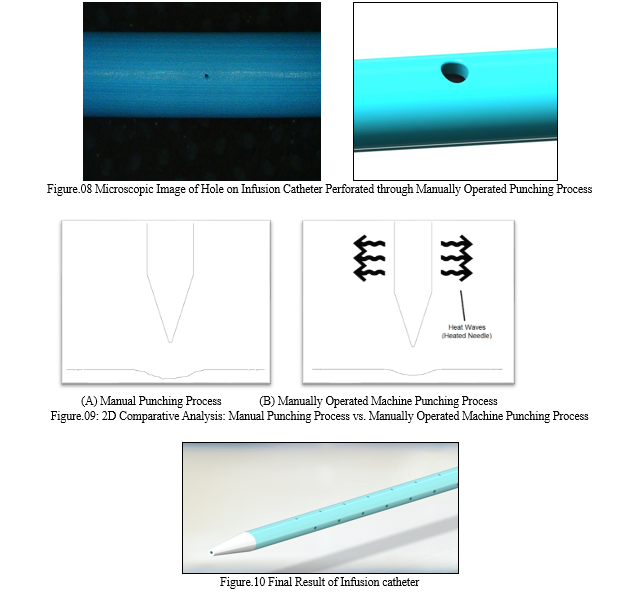Ijraset Journal For Research in Applied Science and Engineering Technology
- Home / Ijraset
- On This Page
- Abstract
- Introduction
- Conclusion
- References
- Copyright
Manually Operated Hole Punching Machine for Development of Catheters
Authors: Minocha Dr. Pramod Kumar, Kothwala Dr. Deveshkumar Mahendralal, Shaikh Amirhamzah Mahmadiqbal, Bhandari Yashkumar Bipinbhai, Patel Shivam Sureshbhai
DOI Link: https://doi.org/10.22214/ijraset.2024.58003
Certificate: View Certificate
Abstract
The catheters are the flexible tubing which are used to deliver fluids into or withdraw fluids from the body. Catheters play a crucial role in the medical manufacturing industry. In thrombectomy applications, they are utilized to aspirate thrombus from the vasculature, while in other instances; catheters are employed to deliver infusion or therapeutic fluids inside the vasculature. Their significance is undeniable in various medical procedures and treatments. For the preparation of these types of catheter, the laborious procedure poses challenges in terms of time, effort, and precision. This research article is describing a ‘Manually Operated Hole Punching Machine’ specifically designed to address these challenges and streamline the catheter development process. The machine is manually operated and requires only a few simple steps to accomplish its intended purpose. The key innovation of this machine lies in its robust hydraulically operated scissor mechanism, which enables convenient punching or punching inside the catheter. By incorporating this mechanism, the machine ensures ease of operation and enhances its overall functionality. The scissor mechanism has been carefully designed and optimized to provide accurate and controlled punching actions, minimizing the risk of damage to the catheter. The primary objective of developing this machine is to conduct various trials during R&D stage to check the feasibility of catheters and also reduces cost; however, it also offers the capability to punch holes in various types of tubing within the applicable size range. This versatility enables the machine to be employed in diverse applications beyond catheter development. The research findings demonstrate the potential of this machine to streamline and improve the efficiency of catheter installation processes while offering the possibility of wider applications in the medical industry.
Introduction
I. INTRODUCTION
The manually operated hole punching machine is a specialized device meticulously crafted to facilitate the creation of precise holes in catheters used in specific applications such as cardiovascular, urological, gastrointestinal, neurovascular procedures, etc. Distinguishing itself from automated machines, this manual device presents unique advantages in terms of user control and flexibility. Its thoughtful design incorporates crucial components, such as groove slots specifically designed to guide catheters, thereby guaranteeing impeccable positioning throughout the hole punching process. Furthermore, the guide ways vertical pillar of this machine are meticulously mounted and aligned perpendicular to the base, ensuring flawlessly accurate vertical movement without any errors during the punching procedures.
The manual operation of this machine enables healthcare professionals to make delicate adjustments, rendering it well-suited for working with metallic needles and hollow pre-profiled punches. By offering fine-tuned control, it ensures a seamless and efficient operation during punching processes. This machine would serve as a reliable tool for healthcare professionals, providing them with the means to create precise holes in catheters with utmost accuracy and efficiency.
In addition to its primary application in catheter manufacturing, this manually operated machine offers the versatility to punch holes in various tubing that meets the corresponding size specifications. This exceptional adaptability broadens its utility beyond catheters, presenting potential advantages across diverse industries that demand precise hole creation. By accommodating different types of tubing, this machine becomes a valuable asset in numerous sectors, catering to a wide range of specific requirements and enhancing productivity and accuracy in hole creation processes.
With its user-friendly interface and sturdy hydraulic scissor mechanism, the machine is likely to provide ease of operation for R&D purposes and prototype preparation. It emphasizes safety measures to ensure the well-being of both patients and operators, while also incorporating quality control processes to guarantee the accuracy and reliability of the hole punching. As the medical field continues to evolve, there is room for further developments and enhancements in manually operated hole punching machines.
Future advancements may include ergonomic improvements, automation features, and integration with other medical equipment for a more streamlined and efficient product development process.
In the current research study, we have successfully engineered a ‘manually operated hole punching machine’ that holds significant potential as an invaluable instrument in the product development process of catheters. This device, characterized by its manual operation, versatility, and unwavering focus on safety and precision, stands as an indispensable tool for healthcare practitioners who would aspire to manufacture catheters of the utmost quality and attain the pinnacle of patient care excellence.
II. MATERIALS AND METHOD
To achieve proper alignment and secure positioning, the catheter is inserted into the designated slots on the machine bed. The machine assembly comprises two separate parts that are interconnected through a hydraulic scissor mechanism, enabling convenient access and adjustment while performing punching operations. Figure.01 illustrates the two-dimensional (2D) view of the complete machine unit, highlighting all the essential components.
Figure (A) depicts the three-dimensional (3D) view of the complete machine unit which shows the actual representation of the machine. Figure (B) depicts the initial position of the machine during the procedure which indicates the extreme position of lever in forward direction. When the user pushes the lever in forward direction, the moving element is lifted up represented by height (H1). During this process the user can adjust the dimension, spacing/gap of the needles if required from the given scale, the user can change/add/remove the needles from the moving element. During this stage, the pre-set parameters can be re-modify as per user need. Also can set newly parameters in the machine for beginning the procedure. Figure (C) depicts the intermediate position of the machine during the procedure which indicates the lever in intermediate position. During this process, the user can align the needles on the catheter to be punched by pulling the lever in backward direction, the moving element is pushed down represented by height (H2). Figure (D) depicts the final position of the machine during the procedure which indicates the extreme position of lever in backward direction. During this process, the user can punches the needles on the catheter by pulling the lever in backward direction, the moving element is pushed down represented by height (H3). The user visually verifies the punching process on the catheter and accordingly adjusts the height of moving element by controlling the lever in forward and backward direction and Figure.02. illustrates detailed view of the gripper jaw chuck and base unit featured with an adjustable angle. The input power supply for temperature controller is not shown in the figures.



A diverse range of components exists, each serving specific functions within a system or device. These components play crucial roles in enabling desired functionalities and ensuring optimal performance.
- Base: The foundation comprises the gripper jaw and the support bars, which serve the purpose of securely grasping the catheter or tubing in a stationary orientation. The gripper jaw exhibits the capability to rotate the tubing or catheter to the desired angle. The gripper jaw chuck and the proximal holding unit can be rotated at the desired degrees of position from 0 to 360 degrees as per the requirement of the operator. Also the gripper jaw can be aligned at the desired angles from 0 to 90 degrees to set the catheter at particular angles as shown in figure.02. Here 0 degree must be in line with the gripper central support arm (not shown in the figure).
- Vertical Pillars: On either side, the presence of vertical pillars serves the purpose of establishing a vertical pathway for the mobile component. These pillars facilitate the connection between the base and the top beam, ensuring structural integrity and support.
- Moving Element: The dynamic component encompasses adjustable slots designed to securely hold various tools such as needles and punching tools. Additionally, it incorporates a heating coil that connects to the tool fixture, enabling heating of the fixture to a precise temperature range of 80 ± 10 degrees Celsius. Temperature adjustable knob, which is not depicted in the provided figure, is employed to regulate the desired temperature. Figure (A) – (D) depicts the temperature controller module mounted on the vertical pillar with an input power cord.
- Scissor Mechanism: The scissor mechanism entails a configuration of interconnected links in a cross-shaped arrangement, affixed to each other via a central pivot point. One section of the upper link is connected to the Piston cylinder assembly, while the opposing end of the upper link is firmly attached to the vertical pillar. The lower extremity links are equipped with rollers that glide within the grooves designated in the moving element. The primary purpose of this mechanism is to impart vertical upward and downward motion to the moving element.
- Hydraulically operated lever mechanism: The hydraulically operated lever mechanism comprises a piston and cylinder assembly, featuring two opposing faces, which are interconnected by means of a hose pipe. An oil-based working fluid is utilized to transmit power from one piston to the other when the lever is pushed forward, facilitating the movement of the upper scissor link (known as the free link). This motion compresses the link, bringing it closer together, thus generating a downward force that enables punching operations. As the upper end of the link approaches proximity, the mobile element is compelled to move downwards, facilitated by the guidance provided by the vertical pillars. Conversely, when the upper link ends move further apart, the moving element undergoes an upward motion.
The hydraulic piston and cylinder assembly operates based on Pascal's Law, allowing precise movement with minimal force that can be easily controlled by the user. The machine's top section contains metallic needles arranged evenly and held in a tool fixture on a moving element. These needles can be customized and adjusted to meet specific requirements, playing a crucial role in creating holes in the catheter. They generate heat through a heating coil, aiding in the punching process with accuracy and precision. Careful design ensures smooth and uniform hole surfaces, reducing friction and discomfort for patients during catheter insertion.
The upper part of the machine applies pressure to the lower bed, where the catheter is securely mounted. This pressure ensures stability and accuracy during the hole creation procedure. By using predetermined settings, the machine consistently and uniformly carries out the hole creation process.
Power is transmitted to the moving element through a scissor mechanism driven by a hydraulic piston. The hydraulic system operates on the principle of Pascal's Law, with a lever on a smaller hydraulic cylinder manually transmitting force to the larger upper hydraulic piston. The lever is used to operate the hydraulic cylinders, and a hose pipe connects the outlet portions of both cylinders facing each other. The smaller cylinder and hose pipe are filled with a working fluid, such as oil. Figure.03 illustrates the hydraulically operated lever mechanism designed for precise power transmission.

Once the necessary perforations have been made on one side of the catheter, the catheter mounting simply requires a specific rotational movement to punch holes on the remaining sides, adhering to the manufacturing specifications. This rotational process ensures precise hole placement across all sides of the catheter, meeting the required manufacturing standards. The rotation and hole punching procedure is completely performed manually, granting the user the flexibility to make necessary adjustments and ensure seamless operation. This manual control facilitates user-friendly usage, empowering individuals to personalize the punching process according to their specific requirements and preferences.
Furthermore, the hole size can be adjusted by utilizing needles of different sizes. This feature enables the machine to provide a wide range of hole dimensions. By employing needles with varying diameters, the machine can effortlessly create holes of diverse sizes in the catheter. It is recommended that for punching process, the needles to be used must be hollow in profile which results in removal of blanks out from the punching area. This versatility enables the production of catheters with customizable hole sizes, catering to a broad spectrum of medical procedures and patient needs.
The ability to modify the hole size enhances the flexibility and adaptability of the manually operated hole punching machine, expanding its capacity to accommodate changing requirements. Figure.04 illustrates the assortment of needles and hollow punches utilized during the punching process, exhibiting distinct diameters.
The machine is capable of operating within a range of hole sizes, from 0.002" to 0.006" (50 microns to 150 microns) for catheters which requires smaller size of pores/holes. However, for the catheters requiring larger holes, it has the ability to punch holes with diameters (diameter of hole) up to 8 mm. As a result the overall operational range of the machine comprise from 0.01 mm to 8 mm.

The incorporation of a manually controlled hole punching machine in the development of catheters provides several advantages and benefits. By being able to punch holes in various forms, such as oval or elliptical shapes, the machine meets the specific requirements of aspiration catheter as per the type of catheter to be fabricated.
The aspiration catheters used in medical procedures require specialized hole shapes to facilitate the aspiration process. These holes allow for the effective removal of unwanted fluids or materials from the body. The ability of the machine to produce holes in a variety of shapes enables the creation of aspiration catheters that are tailored to specific medical operations and patient demands. This customization enhances the versatility and adaptability of the machine, making it a valuable tool in the prototype development process. The manually controlled nature of the machine provides ± 0.02 mm of accuracy in the operation. Operators can adjust and control the punching process to achieve the desired shape and size of the holes. This level of manual control ensures accuracy and consistency in the production of all different types of catheters, which is crucial for their safe and effective use in medical procedures. Furthermore, the machine's capability to produce holes in various shapes expands the range of applications for catheters. Different medical conditions and patient needs may require specific hole shapes to optimize the operational process. The machine's ability to accommodate these diverse requirements allows for the creation of catheters that are tailored to different medical scenarios, ultimately improving patient outcomes.
Aspiration catheters are designed to remove clots from the body which restores the flow of blood and therefore require larger pathways inside the catheter. This necessitates the use of bigger pores to enable efficient clot suction. To create these larger holes, PTFE mandrels of various diameters can be introduced into the catheter and used to punch holes in its walls using boring tubes with the required diameter. By using mandrels of different sizes, the aspiration catheters can be customized to meet specific needs while allowing flexibility in achieving the desired hole size. This capability ensures that the aspiration catheters have holes that are the right size for effective clot removal, resulting in optimal performance of the medical device.
The technique used to make holes in aspiration catheters also enables the device to punch holes at different angles. The machine is able to achieve larger diameter punches inside the catheter walls due to its flexibility in angle configuration. The machine can be manually adjusted to various angles in accordance with the particular specifications of the catheter design. Besides, the amount of heat applied to the boring tubes can be controlled through a temperature-adjustable knob. Meanwhile this feature ensures that the heat level is enough optimized for the process of punching, which further enhances the precision and allows consistency for accurate creation of holes.
III. RESULTS AND DISCUSSION
The practical demonstration involved utilizing a manually operated punching machine on the catheter. The punching machine was manually operated following a previously mentioned method or procedure. A comparative analysis was conducted between the outcomes of punching holes using the aforementioned machine and the manual punching process.
A. Manual Hole Punching Process
The in-house manual hole-making process involved multiple iterations and measurements to precisely determine the location of each hole on the catheter. The manual hole punching process, as depicted in figures.05 and 06, proved to be laborious when performed internally. It necessitated repeatedly measuring specific distances for each individual hole, resulting in numerous inaccuracies in the final catheter output. In summary, the manual handheld method, involving self-performed hole punching with a needle, left the surface of the holes rough, potentially compromising the overall quality of the catheter, as illustrated in figure.07.

B. Manually Operated Hole Punching Machine
A manually operated hole punching machine was utilized in-house, following the aforementioned method. In contrast to the manual punching approach, this machine proved to be efficient without requiring specialized training for catheter engineers. The machine yielded smoother surface finishes for the holes inside the catheter. Unlike the manual method, there was no need for repeated measurements during hole punching, as the machine could achieve consistent punching with a single preset setting. The application of heat to the needles during manual operation, helped in obtaining a smooth surface finish, eliminating roughness as shown in the figure.08. A 2D pictorial representation of the comparison is provided in figure 09. Innovative design features of the machine, including the hydraulic scissor mechanism and dedicated catheter slots, were seamlessly integrated, resulting in smoother operation and increased overall manufacturing output. Special attention was given to the area surrounding the holes to ensure precise accuracy. Through meticulous design considerations, roughness and irregularities were effectively minimized, ensuring a friction-free and painless experience for patients during catheter insertion. The final results of the infusion catheter are observed in figure.10.

Conclusion
In conclusion, the introduction and utilization of the manually operated hole punching machine have revolutionized the production of different types of catheters. This machine has greatly improved product development efficiency, enabling precise and customizable punch hole creation. Its innovative design features would empower medical experts to meet the increasing demand for high-quality catheters with utmost accuracy and precision with low cost. The machine\'s capability to adjust punch hole sizes, angles, and shapes further facilitates customization to match specific medical procedures and individual patient needs. Notably, its user-friendly nature eliminates the requirement for specialized training, making it accessible to workers and engineers of all skill levels. Moreover, the machine\'s simplicity and cost-effectiveness contribute to its eco-friendly attributes and widespread acceptance among customers, patients, and medical experts. Overall, the manually operated hole punching machine would significantly elevate the product development process at low cost.
References
[1] R. Mardane, U. Gulhane and A. Sahuis, \"Design and fabrication of automated attachment for positioning bed of punching machine with respect to cad model,\" IJARIIE, vol. 2, no. 4, pp. 95-100, 2016. [2] Prakash R.S., Singh, R.D., Singh, B., Prakash, S.A. and Koshy, V. (2018). Design and Fabrication of Multi Axis Punching Machine, International Journal of Innovative Research in Technology, 4, (11), 702-706. [3] G. Niranjan, A. Chandini and P. Mamatha, \"Automated Punching Machine with Depth Controllability,\" International Journal of Science and Engineering Applications, vol. 2, no. 4, pp. 90-93, 2013. [4] Gupta, H.N., Gupta, R.C. and Mittal, A. (2009). Manufacturing Processes, (2nd Ed.), New Age International (P) Limited Publishers. [5] K. Barad, M. Balsara, G. Patel and S. Sheth, \"Automation of conventional radial punching machine,\" in nnovations in Mechatronics Engineering, 2009. [6] “Design, Manufacturing & Analysis of Hydraulic Scissor Lift”, Gaffar Momin, et al, International Journal Of Engineering Research And General Science Volume 3, Issue 2, Part 2, March-April, 2015,ISSN 2091-2730 [7] Kumar, J.S.S. and Sekhar, S.R.S. (2015). An Experiment Study on the Influence Cutting Parameters on Thrust Force” While Punching on Different Materials. International Journal and Magazine of Engineering Technology, Management and Research, 2 (1) 327-336. [8] “Design & Analysis of Hydraulic Scissor Lift” M. Kiran Kumar, J. Chandrasheker, International Research Journal of Engineering and Technology (IRJET) e-ISSN: 2395 -0056 Volume: 03 Issue: 06 June-2016 www.irjet.net p-ISSN: 2395-0072 [9] Widiyono E., Winarto, Wardhani R., Rusdiyana L. (2011). Engineering Design of a Gang Punching Machine Equipped with Jig and Fixtures to make A Prototype Machine in Birdcage Production, The Journal for Technology and Science, 22, 4, 214-220. [10] Leventon, W., “Unconventional Machining Options Make Their Mark”, Medical Device and Diagnostic Industry, February 2004, pp. 68-72. [11] Körner, C., R. Mayerhofer, M. Hartmann and H.Bergmann, “Physical and Material Aspects in Using Visible Laser Pulses of Nanosecond Duration for Ablation”, Appl. Phys. A, 63, 1996, pp.123-31. [12] Voisey, K.T., C.F. Cheng, and T.W. Clyne. “Quantification of Melt Ejection Phenomena during Laser Punching in Laser-Solid Interactions for Materials Processing”, MRS, 2000, San Francisco. [13] Dausinger, F., “Punching of high quality micro-holes”, The Industrial Laser User, No. 22, March 2001, pp. 25-27. [14] Dausinger, F., “Femtosecond technology for precision manufacturing: Fundamental and technical aspects”, RIKEN Review No. 50 (January 2003): Focused on Laser Precision Microfabrication (LPM 2002), pp. 77-82.
Copyright
Copyright © 2024 Minocha Dr. Pramod Kumar, Kothwala Dr. Deveshkumar Mahendralal, Shaikh Amirhamzah Mahmadiqbal, Bhandari Yashkumar Bipinbhai, Patel Shivam Sureshbhai. This is an open access article distributed under the Creative Commons Attribution License, which permits unrestricted use, distribution, and reproduction in any medium, provided the original work is properly cited.

Download Paper
Paper Id : IJRASET58003
Publish Date : 2024-01-12
ISSN : 2321-9653
Publisher Name : IJRASET
DOI Link : Click Here
 Submit Paper Online
Submit Paper Online

